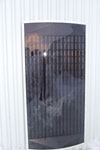Slammed with the sudden increase in oil during the winter of 2007, my spouse and I started looking at alternative energy sources for heating our home.
I noticed in a Canadian Tire flyer that they were selling solar panels for residential use. At almost $2000 they were pretty pricey and the wattage they put out might power a 60 watt light bulb and a small radio.
Geothermal sounded great to us as it was a way of “getting off the oil tit” entirely. Unfortunately we live in an eighty-year-old house and the retrofit would have doubled the already hefty price (around $20,000) for the unit. And because it runs on electricity, your light bill goes up drastically.
Then we thought “Hey wind power! Of course!” but with local zoning laws and a low buy-back rate from the regional electric company for surplus electricity, we had to nix that idea too.
Supplementing oil heat with wood heat is very popular in our area and we considered this option as well. But with both of us working full time we couldn’t see us chopping wood and starting fires for hours a day. There’s also the storage and mess when dealing with wood that really killed our interest in pursuing it as an option.
Enter James Meaney of Dildo, Newfoundland and his company Cansolair, that manufactures solar panels for heating your home. Unlike conventional solar panels that convert solar energy into electricity used to heat up water using an electric water heater, the Model RA 240 Solar Max is a forced convection solar heating unit.
Cold air is pumped by a small fan from the bottom of a room through a small duct into the solar panel where it is heated up and then pumped back into the room. According to Mr. Meaney, all you need is fifteen minutes of sun an hour for the unit to start saving you money on your heating bill. The price was a draw as well — only $2500 per unit.
Most forms of alternative energy available to the average homeowner cost a lot of money to set up and don’t “pay for themselves” for around 20 years. It can be a major investment and is usually best done when the house is built. With some testimonials stating a savings of a tank of oil per Cansolair panel, the unit would pay for itself in three to six years.
Cansolair is currently building its distribution but has already been sold in Australia, Europe and North America. They are currently working on adapting their solar panel design for other uses like water heating. Good luck to this Canadian inventor. He’ll be hearing from us soon!


Really enjoyed reading your blog post. I will have to bookmark your site for later.
Shelling out $2000 just to power a 60 watt light bulb and a small radio is ridiculous to most people. No one will want to pay so much to see so little “results”.
The idea of directly heating air using solar radiation is not new, but really interesting. Instead of relying on the inefficient photovoltaic technology, why not simply heat up the air directly? Cool… Thanks for sharing this idea and your experience. Enjoy your solar heater!
There’s a do-it-yourself version of this type of solar heater.
http://www.squidoo.com/beercansolarheater